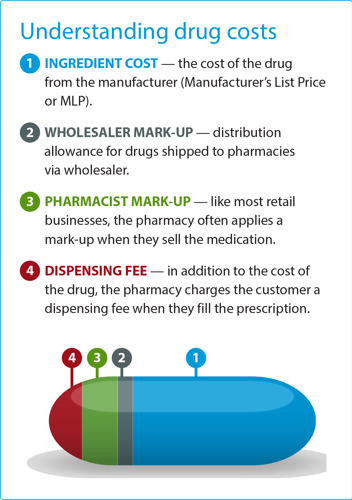Breaking down the cost of prescription drugs
Friday, Feb 8, 2019Rising drug costs are making it harder for people to afford prescription drugs. When filling your prescription at the pharmacy, have you ever wondered what makes up the price of your drugs and if there are any ways to help reduce the cost?
Dispensing fees and mark-ups are two factors that affect the price of prescription drugs. To help control increasing costs, you can shop around for the lowest dispensing fees and markup. This lowers your out-of-pocket expenses if your health care plan does not fully cover prescription drug costs or dispensing fees and maintains the sustainability of your health care plan.
What is a dispensing fee?
A dispensing fee charged to you by the pharmacy covers services such as verifying a prescription, reviewing of your medications profile to check for interactions, identifying and resolving problems with the prescription, billing to a third party, and patient counselling. It can vary from pharmacy to pharmacy. Pacific Blue Cross data shows dispensing fees can range from $4.49 to $15 or more. The average is approximately $10.
What is a mark-up?
A mark-up is a percentage added to the manufacturer’s list price of a drug. It includes a wholesale mark-up and retail mark-up which can vary quite significantly between pharmacies.
Did you know some pharmacies can charge an average mark-up as low as 2%, and some as high an average of 92%? We work to negotiate the lowest possible rates in our Preferred Pharmacy Network (PPN). You can use our Pharmacy Compass Tool to find the best prices in your area.
Understanding drug costs
